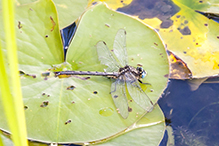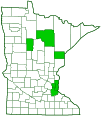lilypad clubtail
(Arigomphus furcifer)
Conservation • Description • Habitat • Ecology • Distribution • Taxonomy
|
|
|||||||||||||
Description |
Lilypad clubtail is an early season, medium-sized, pond clubtail. It is found from Maine and Virginia to Minnesota. Its range includes most of Wisconsin but barely makes it across the border to Minnesota. The thorax of the male is pale grayish-green with black markings including two thin upper (dorsal) stripes, a broad shoulder stripe, and a side (lateral) stripe arches around to join the middorsal stripe at the end. The female thorax is yellowish but is otherwise similar. The abdomen is slender and black with yellow markings. The upper (dorsal) surface or abdominal segments 1 through 7 have narrow, elongated, lance-shaped spots. Segment 8 sometimes has a sort yellow streak, segment 9 is unmarked, and segment 10 is mostly yellow on top. Segments 8 and 9 also have bright orangish-brown patches on the sides. On the male the end of the abdomen is only slightly expanded into a “club” that is widest at segment 8. The claspers at the end of the abdomen point inward and are often yellow. On the female the abdomen is tapered from segment 7 to a very narrow segment 10. The head is small. The large compound eyes are azure blue. They do not meet at the top of the head. The area behind the compound eyes at the top of the head (occiput) is straight across or only slightly convex. The legs are black. The wings are clear except for dark stigmas. The wing triangle, a section of intersecting veins about 20% of the way from the base to the wingtip, is about the same size in the forewing and the hindwing. |
Size |
Total length: about 2″ |
Similar Species |
Horned clubtail (Arigomphus cornutus) has a broader abdomen with wider dorsal spots, including a dorsal spot on segment 8. The occiput is convex and very high, especially so in the female. |
Habitat |
Marshy ponds, lakes, and slow streams with submerged vegetation and brushy shores |
Ecology |
Season |
Late May to early August |
Behavior |
It often perches on lilypads, hence the common name, but also on other floating vegetation, small trees, and sometimes the ground. |
Life Cycle |
After mating the females deposits eggs by flying close to the water surface and tapping the tip of her abdomen into water. After the eggs hatch the young (naiads) live in submerged vegetation. When they mature they crawl onto a lily pad or partly out of the water on a vegetative stem to emerge as adults. |
Naiad Food |
|
Adult Food |
|
Distribution |
||
|
Sources |
|
| 8/2/2025 | ||
Occurrence |
||
Uncommon |
||
Taxonomy |
|
Order |
Odonata (Dragonflies and Damselflies) |
Suborder |
|
Superfamily |
Gomphoidea |
Family |
Gomphidae (clubtails) |
Genus |
Arigomphus (pond clubtails) |
Superfamily Genus |
|
Subordinate Taxa |
|
|
|
Synonyms |
|
Gomphus furcifer |
|
Common Names |
|
lilypad clubtail |
|
Glossary
Naiad
The aquatic larval form (nymph) of a dragonfly, mayfly, or stonefly.
Occiput
The back of the head. In Odonata, Megaloptera, and Neuroptera, the upper part of the head behind the eyes.
Stigma
In plants, the portion of the female part of the flower that is receptive to pollen. In Lepidoptera, an area of specialized scent scales on the forewing of some skippers, hairstreaks, and moths. In other insects, a thickened, dark, or opaque cell on the leading edge of the wing.
Visitor Photos |
||
Share your photo of this insect. |
||
This button not working for you? |
||
|
||
|
||
MinnesotaSeasons.com Photos |
||
 |
 |

Slideshows |
|

Visitor Videos |
||
Share your video of this insect. |
||
This button not working for you? |
||
|
Other Videos |
||
Arigomphus furcifer pseudopupils 21 June 2014 IMGP4900.mov |
About
Published on Jun 22, 2014 Arigomphus furcifer pseudopupils 21 June 2014 IMGP4900.mov |

Visitor Sightings |
||
Report a sighting of this insect. |
||
This button not working for you? |
||
|
|
MinnesotaSeasons.com Sightings |
||

Created: 10/19/2015 Last Updated: © MinnesotaSeasons.com. All rights reserved. |
